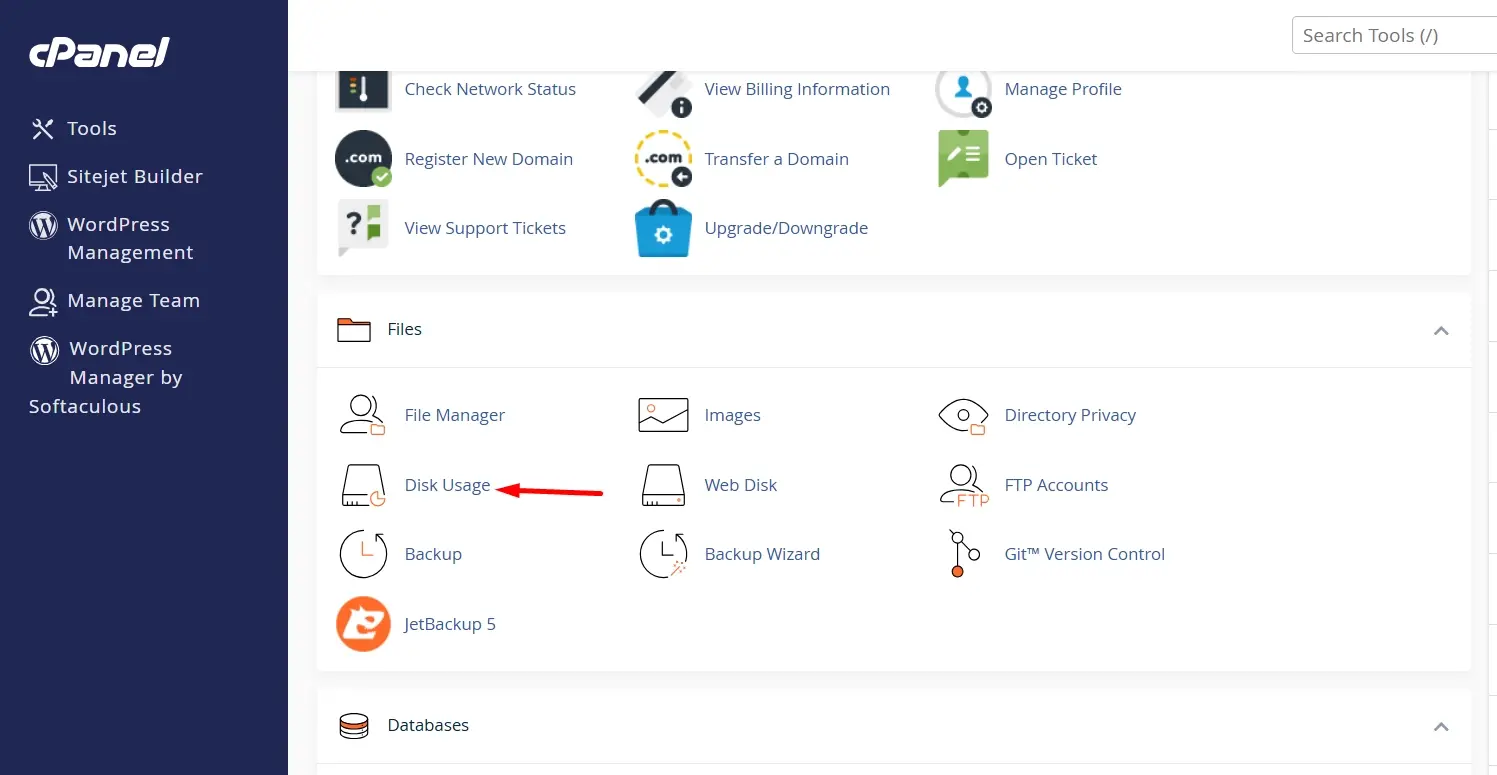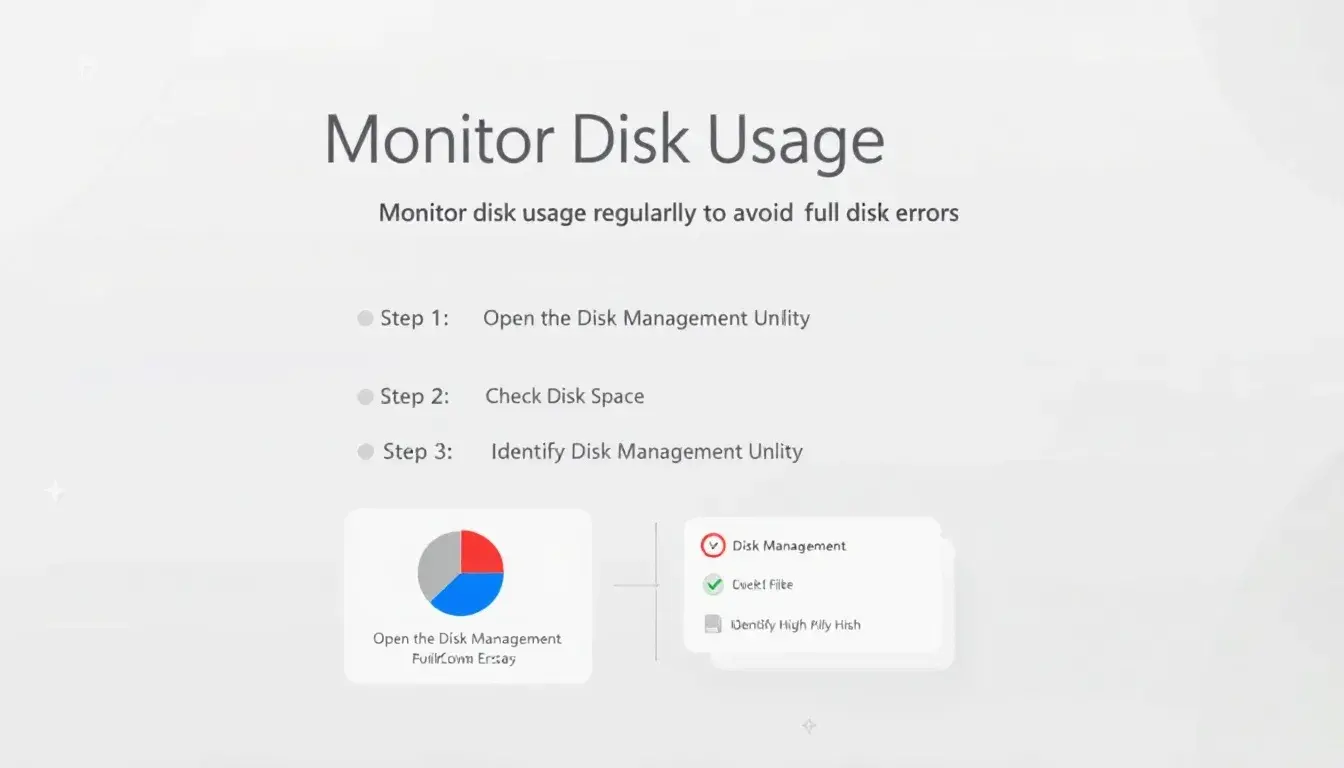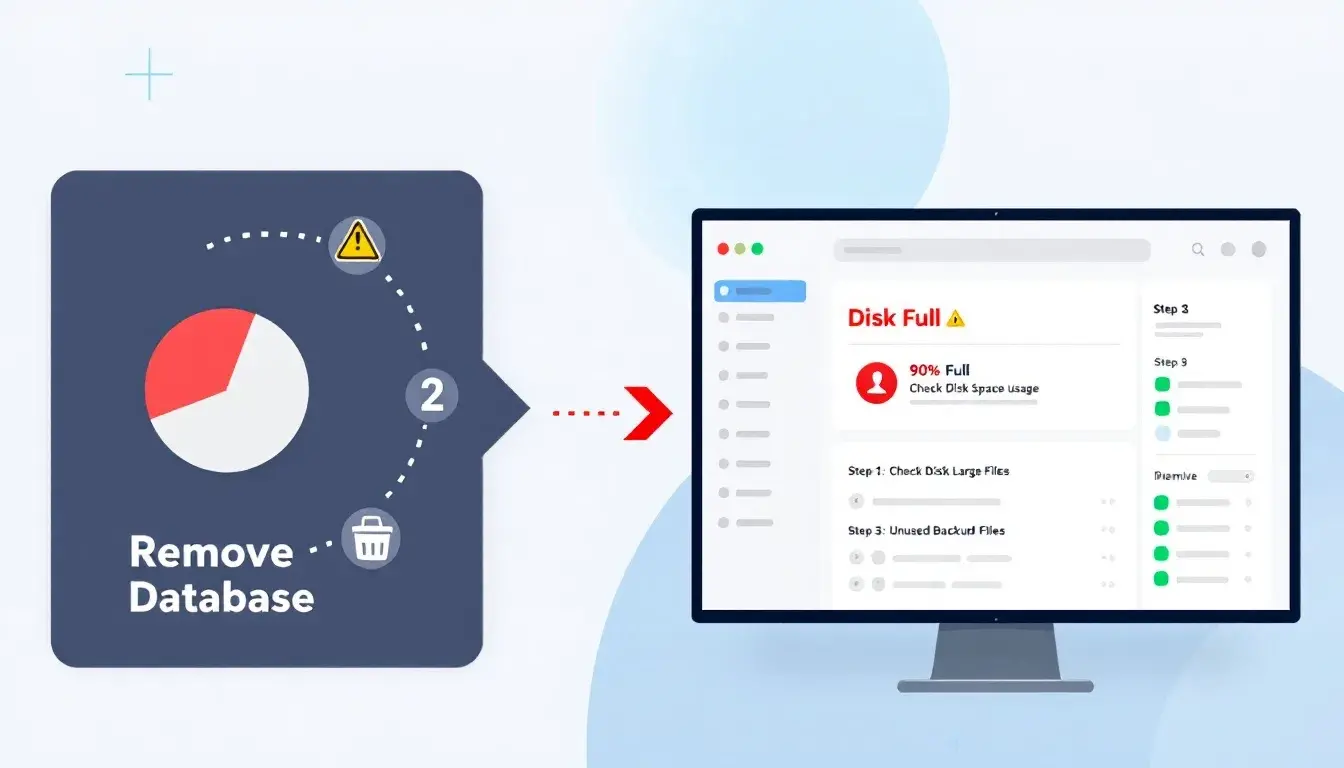Few things disrupt a website faster than a “Disk Full” error. This common issue occurs when your hosting server runs out of storage space, leaving no room for new data, files, or processes to run. From uploading new images to installing updates or just keeping your site running, a full disk can stop everything in its tracks.
When this happens, your website may start showing critical errors, rejecting file uploads, failing to process transactions, or going offline entirely. It can also affect related services, like email if they share the same hosting space. Common causes include excessive backups, large media files, or a growing database that has not been optimized.
If left unresolved, disk full errors can impact your site's performance, cause downtime, and result in lost visitors or sales. Fortunately, fixing the issue is straightforward once you understand what’s consuming your space and how to clear it. In this guide, we will walk you through practical solutions to free up storage and prevent future interruptions.
TL;DR:
A “Disk Full” error means your server storage is maxed out. First, pinpoint what’s heavy (cPanel/Plesk/SSH), then clear space: delete old backups and logs, remove unused themes/plugins, compress or offload large media to a CDN/cloud, and optimize the database. Tidy up email storage, too. If limits persist, upgrade your hosting plan and enable alerts to monitor usage. Prevent repeats with scheduled cleanups, offsite backups, image optimization, and periodic plan reviews—contact support if usage looks abnormal or returns quickly after cleanup.
Why Does the Disk Full Error Happen?
A disk full error does not happen overnight. It is usually the result of gradual storage buildup from different parts of your website and hosting account.
1. Accumulation of Backups: Automatic backups are essential, but if old backups are not removed or stored offsite, they pile up quickly and consume valuable disk space.
2. Unused Themes and Plugins: Over time, websites collect inactive themes and plugins, which take up space even when they are not in use. These add unnecessary weight to your storage.
3. Large Media Files: High-resolution images, videos, and downloadable files can rapidly fill your storage, especially if they are uploaded without optimization.
4. Email Storage Bloat: If your hosting account manages emails, full inboxes, sent folders, spam, and trash can silently occupy large amounts of space over time.
5. Database Growth Over Time: As your website operates, your database grows with new posts, comments, user data, and logs. Without regular maintenance, it can become bloated and contribute significantly to disk usage.
By identifying which of these areas are causing the problem, you can take targeted actions to free up space and restore your website's normal operation.
Step-by-Step Solutions to Fix the Error
Resolving a disk full error requires a mix of cleaning, optimizing, and sometimes upgrading your hosting plan. Follow these practical steps to free up space and keep your website running smoothly.
Step 1: Check Disk Usage

Before making any changes, find out exactly what’s consuming your storage. Most hosting platforms provide tools to help you identify large files and folders.
- In cPanel: Use the "Disk Usage" feature under the Files section.
- In Plesk: Go to Statistics to see detailed storage reports.
- Using SSH: Run commands like
du -sh *to check directory sizes from the terminal.
If you are using a provider like Verpex, you will have easy access to these tools within your hosting dashboard, making it simple to monitor and manage disk space effectively. This helps you pinpoint problem areas and prioritize what to clean up.
Step 2: Delete Unnecessary Files
Once you have identified large or outdated files, start clearing out anything no longer needed.
- Delete outdated backups stored on your server.
- Remove unused themes, plugins, and media files from your CMS.
- Clear out old log files that accumulate from server activity.
Always create fresh backups before deleting critical files, just to stay safe.
Step 3: Optimize the Database
Databases can grow quickly, especially if your site handles frequent updates, posts, or user activity. Cleaning up your database reduces storage use and improves performance.
- Remove post revisions, spam comments, and expired transients if you are using a CMS like WordPress.
- Use tools like phpMyAdmin to clear unused data and shrink database size.
Regular optimization helps prevent your database from becoming a hidden source of disk usage.
Step 4: Manage Email Storage
Emails stored on your hosting account can silently consume large amounts of space, especially if you handle multiple accounts or attachments.
- Empty folders like spam, trash, and archives.
- Set up auto-purge rules to automatically delete emails older than a certain period.
This helps keep email storage under control without constant manual cleanup.
Step 5: Move Large Files Off-Site
Big files, such as videos, high-resolution images, or downloadable documents, can quickly overwhelm your hosting storage. To free up space, transfer these to external storage.
- Offload media to a CDN, cloud storage (like Google Drive or Amazon S3), or external hosting services.
- Replace heavy on-site files with external links or embeds.
This strategy keeps your site light while ensuring smooth access to large files.
Step 6: Upgrade Hosting Plan
If cleaning and optimizing are not enough, your website may have simply outgrown its current hosting plan. Upgrading ensures you have the resources to support growth.
- Move to a higher-tier hosting plan with more disk space and better performance.
- Look for scalable options that allow for future expansion as your site grows.
Upgrading prevents recurring storage issues and prepares your site for long-term stability.
Step 7: Set Up Monitoring

Finally, to avoid running into disk full errors again, put monitoring tools in place to keep an eye on storage levels.
- Enable disk usage alerts through your hosting control panel.
- Regularly review storage reports and perform scheduled maintenance.
Proactive monitoring helps you catch storage problems early before they affect your site's performance.
When to Contact Support
While many disk full errors can be solved with regular cleanups and storage management, there are times when reaching out to your hosting provider is the best solution. Contact support if:
You have cleared unnecessary files, optimized your database, and freed up space, but the disk usage remains unusually high.
You suspect hidden files, system-level logs, or processes are consuming space you can not access through your control panel.
You experience repeated disk full errors shortly after resolving them, which may point to deeper server issues.
You need help upgrading your hosting plan or migrating to a solution with more storage capacity.
You are unsure about safely deleting certain files and want expert guidance to avoid causing site errors.
Support teams have access to advanced tools and insights to investigate what's happening behind the scenes and can help restore normal site operations quickly.
How to Prevent Future Disk Full Errors
Once you have resolved a disk full error, the next priority is preventing it from happening again. This requires consistent maintenance and careful monitoring of your website’s storage use.
1. Schedule Regular Cleanups
Create a maintenance schedule to routinely check and clear your hosting account of unnecessary files. Every month or quarter, review your file directories and remove outdated backups, unused plugins, inactive themes, and old media files that are no longer needed. Regular cleanup ensures that temporary files and forgotten data do not quietly consume valuable storage over time.
2. Optimize Your Database Frequently
Your website's database steadily grows as it stores posts, comments, user activity, and other dynamic content. Without optimization, it accumulates overhead that can slow down performance and take up excess space. Use reliable tools regularly remove spam comments, outdated post revisions, and other unnecessary entries that inflate your database.
3. Limit Media Uploads
Large media files, especially uncompressed images and high-definition videos are among the biggest contributors to disk usage. Before uploading, compress files to reduce their size without sacrificing quality. Periodically audit your media library and delete duplicate, outdated, or unused files to prevent your storage from becoming overloaded.
4. Manage Email Storage
If your hosting account handles emails, inboxes can quietly accumulate thousands of messages, especially with attachments. Keep storage under control by clearing out old emails, regularly emptying spam and trash folders, and setting automated rules to delete emails older than a specific time frame. This keeps email data from consuming space reserved for your website.
5. Store Backups Offsite
Keeping too many backups on your server can quickly drain your storage. Move backups to secure, external locations like Google Drive, Dropbox, or dedicated cloud backup services. Automate this process where possible to ensure backups are consistently offloaded without manual effort.
6. Monitor Disk Usage
Enable disk usage notifications within your hosting panel to receive alerts as your storage reaches certain thresholds. Regularly review your disk usage reports to identify trends and spot unusual spikes, which might signal hidden problems like log file growth or bloated directories. Early detection allows you to take action before storage becomes critical.
7. Review Hosting Needs
As your website grows in content, traffic, and features, your storage requirements will increase. Periodically assess whether your current hosting plan still provides enough resources to support your site's activity. If you notice you are frequently approaching storage limits despite good maintenance, it may be time to upgrade to a plan with higher capacity.
By following these focused, proactive strategies, you can maintain a healthy server environment, minimize the risk of future disk full errors, and deliver a consistently reliable experience to your website visitors.
Helpful Tools for Ongoing Disk Management
Managing disk space effectively requires the right tools. These resources can help you regularly monitor, clean, and optimize your website’s storage to prevent future disk full errors:
WP-Optimize: A dedicated WordPress plugin that cleans and optimizes your database by removing unnecessary post revisions, spam comments, and temporary data.
cPanel File Manager: Provides direct access to your server’s file system, making it easy to identify and delete large or outdated files taking up space.
phpMyAdmin: A powerful database management tool that allows you to review, optimize, and clear out unnecessary database entries and overhead.
Email Management Tools: Most hosting control panels include built-in email tools that help you monitor inbox sizes, delete old emails, and automate spam and trash cleanup.
Disk Usage Viewer (cPanel/Plesk): Visualizes disk usage so you can quickly identify which folders and files are consuming the most space, helping you prioritize cleanup efforts.
Image Optimization Plugins (such as ShortPixel or Smush): Automatically compress image files before or after upload to reduce media-related disk usage without sacrificing image quality.
By regularly using these tools, you can stay ahead of storage issues, maintain optimal website performance, and prevent unexpected disk full errors from disrupting your site.
Conclusion
A disk full error can bring your website to a halt, but with the right steps, it is easy to regain control. Regular cleanups, database optimization, and proper file management keep your storage healthy and your site running smoothly.
Staying proactive with routine maintenance and monitoring is the best way to prevent future storage issues and avoid unexpected downtime. And when things feel out of reach, don’t hesitate to contact your hosting provider for expert support.
Take control of your website’s storage today, stay organized, stay optimized, and keep your site running at its best.
Frequently Asked Questions
What should I do if I get a WordPress database error disk on my site?
A WordPress database error disk usually means your server's storage usage has maxed out, blocking your WordPress database from saving or retrieving important data. To fix this, delete unused themes, remove backup files, clear out older versions of plugins, and optimize your unoptimized database to regain enough space for normal operations.
Can unused media files and backup files cause high disk usage?
Yes, unused media files and backup files are common reasons for high disk usage. Over time, they consume significant disk space, especially on a WordPress site that frequently uploads new content. Regularly deleting unnecessary files helps protect your storage space and ensures your site stays fast and responsive.
How can a server administrator manage error logs and storage usage on a WordPress website?
A server administrator can monitor storage usage by checking disk space reports, reviewing error logs, and clearing out unneeded files. It's important to delete temporary files, remove backup files no longer needed, and manage the WordPress database to prevent corrupted data from filling up the hard drive and affecting performance.
What steps can I take on my computer to prevent blocked downloads due to lack of storage space?
If your computer’s hard drive is full and downloads are blocked, navigate to your desktop, right click on the recycle bin, and empty it to clear space. You should also delete older versions of files you no longer need, clear cache from your browser, and remove unnecessary data from your operating system to ensure there is enough space for new downloads.

Yetunde Salami is a seasoned technical writer with expertise in the hosting industry. With 8 years of experience in the field, she has a deep understanding of complex technical concepts and the ability to communicate them clearly and concisely to a wide range of audiences. At Verpex Hosting, she is responsible for writing blog posts, knowledgebase articles, and other resources that help customers understand and use the company's products and services. When she is not writing, Yetunde is an avid reader of romance novels and enjoys fine dining.
View all posts by Yetunde Salami




















